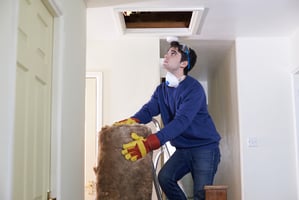If you're getting the house ready for the holidays, chances are it's time to get those decorations...
Before You Insulate that Attic Crawl Space
 The attic crawl space gets the most attention at Christmastime when the decorations come out. The rest of the year, most people ignore it. It’s not filled with heirlooms and Grandma’s goodies. It’s just a crawl space, maybe barely that in the many flat-roofed row homes that abound in Washington, DC. However, when you’re thinking about adding insulation, it could be that your crawl space just stepped up to the most critical place in the house.
The attic crawl space gets the most attention at Christmastime when the decorations come out. The rest of the year, most people ignore it. It’s not filled with heirlooms and Grandma’s goodies. It’s just a crawl space, maybe barely that in the many flat-roofed row homes that abound in Washington, DC. However, when you’re thinking about adding insulation, it could be that your crawl space just stepped up to the most critical place in the house.
Do I Need to Insulate My Attic Crawl Space?
You may wonder if you even need to insulate your attic if it’s just a crawl space. The short answer is yes. The attic is the peak of the house. Even if that open space is small, it is still open, and rising heat won’t slow down until it gets there. If it’s cold outside, you don’t want to lose money because the heat is going to the attic. During our typically hot summers, the heat can build to potentially dangerous levels. Either way, the smart money insulates.
What You Need to Know Before You Insulate
Before you start to insulate the attic crawl space, you need to pay attention to your lighting. Here’s why. Light fixtures are made of materials that conduct heat. Not all types of fixtures are manufactured in the same way. Some could be fire hazards if they touch the insulation. There are two things you need to know about light fixtures and insulation: the type of insulation you need and the rating on the light fixtures.
Insulation comes in various forms, from sheets to foam to batts or loose fill made of fiberglass, cellulose, or mineral wool. The foam is the most expensive type of insulation, and it should not be used for large spaces, even crawl size large. Sheets are rigid and very compressed, so the batts or loose-fill types of insulation are popular attic choices.
It’s essential to know the R-zone you live in and choose insulation suited for the weather. The R-zone is generally easily found on the packaging of the insulation.
How Recessed Lights Can Cause a Fire
Finally, if you have recessed lighting set into the floor-ceiling of the area to be insulated, it’s critical to know whether the lights are IC-rated or non-I IC-rated. The IC stands for Insulation Contact. If your recessed lighting is IC-rated, then it can be used where insulation is present without worry. If the lights are NON- IC rated, do not use them near insulation. The heat will be too intense, and the insulation could combust.
It is easy to find out if your recessed lights are safe around insulation or not. The canister portion of the lighting will be marked with IC or Non-IC. Look for the label and make sure you keep the insulation at least three inches away from Non-IC lighting. Your best bet will be to have a licensed electrician inspect your fixtures and make the necessary lighting replacements or retrofits before you proceed with insulation.
Insulating your attic crawlspace can save you heating costs in a cold climate. It will also help hold in the cool air when the air conditioner is on. It doesn’t have to be a big job, but make sure you insulate safely. Be sure your lighting fixtures are safe, and contact Wilcox Electric.



